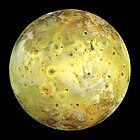Portal:Solar System/Selected article/13
Io (pronounced /ˈaɪoʊ/ eye'-oe, or as Greek Ῑώ) is the innermost of the four Galilean moons of Jupiter and, with a diameter of 3,642 kilometers, the fourth largest moon in the Solar System. It was discovered in 1610 by Galileo Galilei, along with the other Galilean satellites. This discovery furthered the adoption of the Copernican model of the Solar System and the development of Kepler's laws of motion. Unlike most satellites in the outer Solar System (which have a thick coating of ice), Io is primarily composed of silicate rock surrounding a molten iron or iron sulfide core. Io has one of the most geologically active surfaces in the solar system, with over 400 active volcanoes. This extreme geologic activity is the result of tidal heating from friction generated within Io's interior by Jupiter's varying pull. Several volcanoes produce plumes of sulfur and sulfur dioxide that climb as high as 500 km (310 mi). Io's surface is also dotted with more than 100 mountains that have been uplifted by extensive compression at the base of the moon's silicate crust. Some of these peaks are taller than Earth's Mount Everest. Most of Io's surface is characterized by extensive plains coated with sulfur and sulfur dioxide frost. (Full article...)

